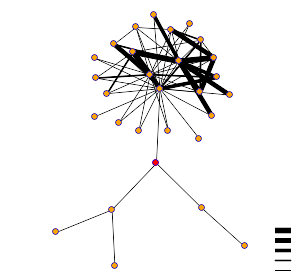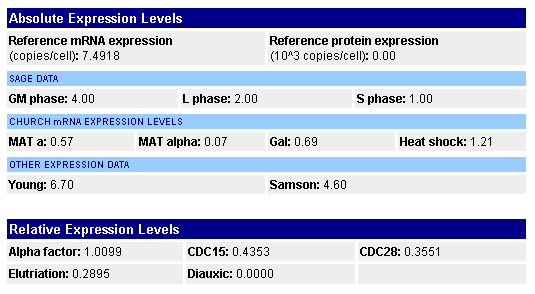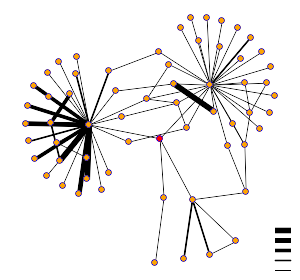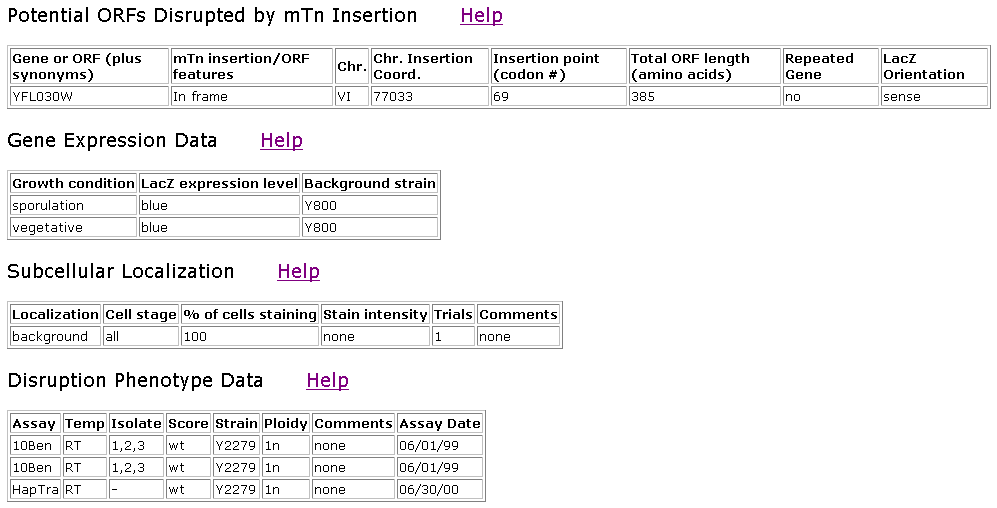My Favorite Yeast Protein(s):
Ste2 (annotated) and YFL030W
(unannotated)
This web page was produced as an assignment
for an undergraduate course at Davidson College.
My Favorite Annotated Yeast Gene's
Protein: Ste2
Many different databases can
reveal pertinent information about a particular gene product. This web page
will go through several of these websites dealing with the protein associated
with the yeast gene Ste2, discussing both the nature of the alpha-pheromone
receptor encoded by it and this protein's place in the overall nature of the
yeast cell.
DIP
The DIP
(Database of Interacting Proteins) website is useful
in finding relationships between gene products, both real and theoretical.
A search in this website for the gene Ste2 yielded relatively uninteresting
results: there were three genes that the researchers thought interacted with
it, but all three were hypothetical proteins (YHR016c, YGR141w, and YOR242c)
and the degree of certainty of their connection wasn't very strong.

A map of the interactions between protein Ste2 (in red) and
other gene products. The cluster above yielded little interesting findings.
Courtesy DIP.
Yale Gerstein Lab
A search of Ste2 at this website
tells us some of what was already known about Ste2; it is found in the membrane
of yeast cells and is not essential for cell viability. This website also
gave some interesting information about expression levels, however.

Courtesy Yale
Gerstein Lab.
This description of the Ste2 protein gives us
absolute and relative levels of expression which may be used in comparison
with other proteins. Again, it confirms what was found in the microarray data
-- Ste2 is especially expressed in great amounts in the presence of alpha
factor.
TRIPLES Database
The TRIPLES
website can be used to search for clones in which the gene in question is
disturbed by a mTn transposon. The results of experiments can then give clues
as to the nature of your gene and its product. Unfortunately, no results were
found for Ste2.
Munich Information Center for Protein
Sequences
The data
from the Munich Information Center for Protein
Sequences database confirms earlier knowledge about Ste2. Indeed, we find
from this website, which utilizes information from SGD
and PubMed,
that internalization of the protein is not important for mating response,
that the receptors localize to the tip of the mating projection, that it is
delivered into the vacuole lumen by transport vesicles, and that the receptor
is not recycled after internalization.
PDF Files on Protein Connections
Searches for Ste2 from the following
files yielded no matches: Aging (PDF
format), Membrane (PDF
format), and Degradation (PDF
format).
YRC Two-Hybrid Analysis
The University of Washington's
Yeast Resource Center's two-hybrid
analysis yielded no hits of Ste2.
WIT
There was no information of use
relating to Ste2 in the What
is There? website.
Experiments/Conclusions
The gene product of Ste2 is so well documented
that, unless it is found to interact with other proteins or gene products
in new ways, most of the searches contain redundant material. Unfortunately,
the new studies done with protein arrays and the like have not had a tremendous
impact towards the alpha pheromone receptor encoded by Ste2. For this reason,
I am hesitant in stating that novel experiments could do a tremendous amount
to further our knowledge of this proteins function. We know that it is necessary
for yeast sexual reproduction and that it is not critical for viability. This
gene product is involved in so much of yeast biology that new experiments
seem tough to develop. However, even though this study seems cut and dried,
there may be some hidden pathway that could be uncovered in years to come.
My Favorite Unannotated Yeast Gene's
Protein: YFL030W
Another important aspect of web
searches is their ability to explain relationships between an unknown protein
and the characterized proteins. By doing searches and examining the proteins
related to the gene product of YFL030W, we can further determine its nature
and test some of our earlier predictions.
DIP
The DIP
(Database of Interacting Proteins) website is especially
useful in this search, as it gives a starting place for looking at some of
the preliminary finding on YFL030W and by examining those proteins that interact
with the annotated gene. This gene is categorized by SwissProt
as a class-V of pyroxidal-phosphate-dependent aminotransferases with a pyridoxal
phosphate cofactor. Four proteins matched the search, including two protein
kinases of note, PHO85 and DUN1. DUN1 is a transducer of the DNA damage signal
while PHO85 is activated when phosphate levels are high, and it phosphorylates
the PHO4 transcription factor which creates repression. Although this initially
might put YFL030W in this group, the confidence the researchers put in this
were fairly weak, so these might not be 'true' interactions.

A map of the interactions between protein YFL030W
(in red) and other gene products. Courtesy DIP.
Yale Gerstein Lab
A search of YFL030W
at this website
had no information on this protein, and merely confirmed what was already
known through previous searches
TRIPLES Database
The TRIPLES
website can be used to search for clones in which the gene in question is
disturbed by a mTn transposon. The results of experiments can then give clues
as to the nature of your gene and its product. Many hits were found using
this website, and all of the mTn transposon insertions yielded a 385 aa protein.
Most of the clones found yielded the same results.

These results indicate that, for this particular
clone, YFL030W is found throughout the
cell stages, and the LacZ expression level indicates that this protein was
being expressed in the cell when the mTn transposition took place. Additionally,
the 'HapTra' Assay is designed to show "cell inviability of haploid transformants"
which may indicate that this protein is necessary for immediate cell function.
The '10Ben' assay shows that there is a Benomyl hypersensitivity when this
gene is disrupted, though the exact importance of this is not immediately
obvious.
Courtesy TRIPLES.
Munich Information Center for Protein
Sequences
The data
from the Munich
Information Center for Protein Sequences database yielded some iteresting
information about YFL030W. This website tells us that the protein product
is catergorized as an aminotransferase with a class-V pyridoxal-phosphate
attachment site. The functional categories it was related to were amino acid
biosynthesis, amino acid degradation, and nitrogen and sulfur utilization.
This relates back to to the DIP search, as it is clear these searches find
some relation between the gene product of this annotated gene and phosphate
kinases, due, presumably, to the site on the protein. The association of YFL030W
to the above functional categories was not previously recorded.
PDF Files on Protein Connections
Searches for YFL030W from the
following files yielded no matches: Aging (PDF
format), Membrane (PDF
format), and Degradation (PDF
format).
YRC Two-Hybrid Analysis
The University of Washington's
Yeast Resource Center's two-hybrid
analysis yielded no hits of YFL030W.
WIT
There was no information of use
relating to YFL030W in the What
is There? website.
Experiments/Conclusions
The gene product of YFL030W
was previously predicted to be involved in aerobic cellular respiration. This
information, however, indicates that it is an aminotransferase.
Based on the searches above, it is a safe assumption
that the DIP searches may not be completely accurate.
The first experiment I would
perform on this protein would be a test of this presumed presence of a "pyridoxal
phosphate cofactor". I would clone the gene then test this interaction
by any number of different ways, including Western blotting or immunofluorescence.
Confirmation of this need for a cofactor would certainly be an important step
in determining the function of protein YFL030W. If this
interaction turned out to be real, further investigations would be needed
to determine the interactions of this protein before and after the cofactor
is added. Following this, understanding the localization of this protein and
possibly further examining its relationship between PHO85
and DUN1. Immunofluorescence of the cell dealing with both of these proteins
could reveal these interactions.
Because the TRIPLES database hinted that this
may be a protein essential for cell viability, knocking out this ORF and testing
for cell viability and general cell characteristics (i.e. reproduction) would
be useful. Immunoprecipitation and yeast two-hybrid (Y2H) studies with this
gene would be interesting, though other than the PHO4 transcription factor
found in the immediate connection to YFL030W,
no other information dealing with transcription factors was found. Using PHO85
and DUN1 as bait proteins would be helpful in determining whether there is
an interaction between these two genes and our unannotated one. Experiments
that would also be useful go back to the gene
expression work. These experiments indicate the involvement of this protein
in aerobic respiration, and, although no searches above confirmed this prediction,
these data could still prove to be useful. By growing yeast cells in aerobic
and anaerobic conditions, as well as with ethanol or acetate added and performing
the above experiments, some of the interactions can be solidified.
Although not much is known about
the function of YFL030W, deductions from its structure and interactions with
other proteins create a patchwork. Using the experiments discussed above,
the actual function of this protein could be deduced.
References (Websites Used):
DIP
Yale
Gerstein Lab
TRIPLES
Munich
Information Center for Protein Sequences
two-hybrid
analysis
What
is There?
Saccharomyces
Genome Database
Return to Dan Pierce's Genomics Web Page
Genomics
Biology
Home Page


© Copyright 2003 Department of Biology, Davidson College, Davidson,
NC 28035
Send comments, questions, and suggestions to: dapierce@davidson.edu



